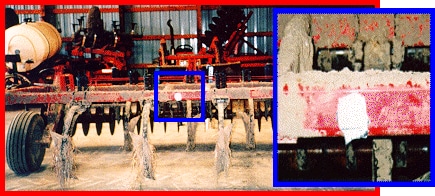Ignition Hazard From Drilling Into Sealed Frames of Agricultural Equipment
July 1998
DHHS (NIOSH) Publication Number 98-146
Description of Hazard
Recently, the National Institute for Occupational Safety and Health (NIOSH), through its Community Partners for Healthy Farming program in New York, received two separate reports of farm workers who were injured while attempting to drill holes into sealed plow frames in order to mount a hitch or a “slow-moving vehicle” sign. These workers received serious skin burns and other injuries when the drill bits penetrated the frames releasing and igniting flammable gases. Hydrogen and methane gas may be produced within sealed frames that are filled during manufacture with scrap metal ballast. The uncleaned, assorted machine shop metal scrap apparently reacts electrochemically with water and emulsion-type cutting oils to liberate flammable gases. Although the reported ignitions involved plows from the same manufacturer, the use of scrap metal fill may not be unique to plows or to that manufacturer. The potential for such ignitions exists in any equipment with similar ballast in sealed compartments during drilling, cutting, welding, or other operations that both release the gases and provide an ignition source.

Ignition Hazard: Drilling, cutting or welding a sealed frame on agricultural equipment can result in a gas explosion.
Safe Practice: Do not drill, cut, weld, or otherwise penetrate sealed frames of agricultural equipment. Attach signs or other objects to frames using clamps or devices that will secure them to the frames without penetration of these frame members.
Recommendations For Prevention
Laws in some jurisdictions require that agricultural equipment be equipped with “slow-moving vehicle” signs prior to traveling on public roadways. Agricultural workers commonly mount such signs on equipment by drilling into, and bolting the signs to the equipment frame. However, due to the risk of ignition and explosion, Agricultural workers should heed the following recommendations:
- Do not penetrate any sealed frames of agricultural equipment
- Use clamps or other non-penetrating devices to secure “slow-moving vehicle” signs or other objects to sealed equipment frames
- If for some reason a sealed frame member must be penetrated, only qualified personnel who are aware of the hazard and its control and use proper equipment and procedures should attempt the operation.
Manufacturers should:
- Use clean, dry steel fill within frame members that is similar in composition to the steel frame; do not use galvanized steel scrap
- Incorporate a pressure relief mechanism into sealed frame members
- Prior to sealing frame members during manufacturing, affix mounting brackets on the frame member for the subsequent mounting of slow moving vehicle signs, hitches, or lights
- Affix labels on equipment that warn not to penetrate sealed members by drilling, cutting, welding, or other methods
- Alert equipment dealers of the potential hazard and instruct them to pass the information on to buyers
- Provide dealers with retrofit warning labels to affix to used equipment.
Additionally, dealers should alert customers of the potential hazards of penetrating sealed members of agricultural equipment by displaying warning signs on dealership walls, and by supplying customers with any safety-related information about this hazard. Agricultural extension agents should also alert farm workers of the potential hazards through personal communications, the media, agricultural meetings, county fairs, or other channels. Universities should alert university agricultural and agricultural engineering departments of the potential hazards of penetrating such plow frames.
Acknowledgments
The principle contributors to this publication are: Isaac A. Zlochower, Michael J. Sapko, Virgil Casini and Jerry Flesch, NIOSH; Jane Boyd, University of Rochester, New York.
Ignition hazard from drilling into sealed frames of agricultural equipment
